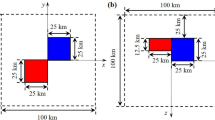Abstract
Due to the fact that the spectrum of a convolution is the product of the spectra of the two convolved functions, the convolution integrals of physical geodesy can be evaluated very efficiently by the use of the fast Fourier transform (FFT) provided that gravity and/or terrain data are available on a regular grid. All Fourier transform-based methods usually treat the gridded data as point values despite the fact that these discrete values may have been obtained by averaging and they represent mean values over the whole area of a grid element. In the frequency domain, this fact can be taken into account very easily, because the spectra of mean and point data are related via a two-dimensional (2D) sinc function. The paper shows explicitly this relationship using the convolution integrals for the evaluation of geoid undulations, deflections of the vertical, and gravity and gradiometry terrain effects. Numerical tests are presented, indicating that the differences in the two approaches may become significant when highly accurate results are wanted. The application of the2D sinc function in the evaluation, update, and inversion of other convolution integrals is briefly discussed as well.
Similar content being viewed by others
References
G.P. BERGLAND: A guided tour of the fast Fourier transform.IEEE Spectrum, Vol. 6, pp. 41–52, 1969.
B.K. BHATTACHARYYA and M.E. NAVOLIO: Digital convolution for computing gravity and magnetic anomalies due to arbitrary bodies.Geophysics, 40, No. 6, pp. 981–992, 1975.
B.K. BHATTACHARYYA and M.E. NAVOLIO: A Fast Fourier transform method for rapid computation of gravity and magnetic anomalies due to arbitrary bodies.Geophysical Prospecting, 24, pp. 633–649, 1976.
R. BRACEWELL:The Fourier transform and its applications, 2nd ed., 444 p., McGraw-Hill, New York, 1978.
E.O. BRIGHAM:The fast Fourier transform. 252 p., Prentice-Hall, Inc., Englewood, New Jersey, 1974.
O.L. COLOMBO: Numerical methods for harmonic analysis on the sphere.OSU Rep. No. 310, Dept. of Geodetic Science and Surveying, The Ohio State University, Columbus, Ohio, 1981.
J.W. COOLEY, P.A.W. LEWIS and P.D. WELCH: The fast Fourier transform algorithm. Programming considerations in the calculation of sine, cosine and Laplace transforms.J. Sound Vib., Vol. 12, pp. 315–337, 1970.
D.H. ECKHARDT: The gains of small circular, square, and rectangular filters for surface waves on the sphere.Bull. Géod., Vol. 57, No. 4, pp. 394–409, 1983.
R. FORSBERG. Gravity field terrain effect computations by FFT.Bull. Géod., Vol. 59, pp. 342–360, 1985.
B.D. FULLER: Two-dimensional frequency analysis and design of grid operators.Mining Geophysics, Vol. 2: Tusla, SEG, pp. 658–708, 1967.
F.J. HARRIS: On the use of windows for harmonic analysis with the discrete Fourier transform. InProc. of the IEEE, Vol. 66, No. 1, pp. 51–83, 1978.
W.A. HEISKANEN and H. MORITZ:Physical geodesy. W.H. Freeman and Company, San Francisco, California, 1967.
S.K. JORDAN: Fourier physical geodesy.Rep. No. AFGL-TR-78-0056 Reading, Massachusetts, The Analytic Sciences Corp., 1978.
E.R. KANASEWICH:Time sequence analysis in geophysics. University of Alberta Press, Edmonton, Alberta, 1975.
A.H.W. KEARSLEY, M.G. SIDERIS, J. KRYNSKI, R. FORSBERG and K.P. SCHWARZ: White Sands revisited—A comparison on techniques to predict deflections of the vertical,UCSE Rep. #30007, Dept. of Surveying Engineering, The University of Calgary, Calgary, Alberta, 1985.
P. MEISSL: A study of covariance functions related to the earth's disturbing potential.OSU Rep. No. 163, Dept. of Geodetic Science and Surveying, The Ohio State University, Columbus, Ohio, 1971.
P. NAIDU: Spectrum of the potential field due to randomly distributed sources.Geophysics, Vol. 33, No. 2, pp. 337–345, 1968.
D.W. OLDENBURG: The inversion and interpretation of gravity anomalies.Geophysics, 39, No. 4, pp. 526–536, 1974.
R.L. PARKER: The rapid calculation of potential anomalies.Geophys. J.R. Astr. Soc., 31, pp. 447–455, 1972.
W.C. PEARSON and C.R.B. LISTER: Trend analysis and fast Fourier interpretation of marine gravity measurements. InProc., of the 7th Annual SPE of IAME Offshore Technology Conference, Vol. 2, No. OTC-2318, pp. 717–730, Houston, Texas, 1975.
K.P. SCHWARZ: Geodetic accuracies obtainable from measurements of first and second order gravitational gradients.OSU Rep. No. 242, Dept. of Geodetic Science and Surveying, The Ohio State University, Columbus, Ohio, 1976.
K.P. SCHWARZ, M.G. SIDERIS and R. FORSBERG: Orthometric heights without levelling.Journal of Surveying Engineering, 113, No. 1, pp. 28–40, 1987.
M.G. SIDERIS: Computation of gravimetric terrain corrections using fast Fourier transform techniques.UCSE Rep. #20007, Dept. of Surveying Engineering, The University of Calgary, Calgary, Alberta, 1984.
M.G. SIDERIS: A fast Fourier transform method of computing terrain corrections.Manuscr. Geod., 10(1), pp. 66–73, 1985a.
M.G. SIDERIS. On the relationship between spectra of mean and point data with applications in computing, inverting, and updating gravity field quantities. InProc. of the International Meeting on Potential Fields in Rugged Topography, Lausanne, Switzerland, July 30–31 and August 1, 1985, pp. 82–87, Institute of Geophysics, Univ. of Lausanne, 1985b.
M.G. SIDERIS: On the application of spectral techniques to the gravimetric problem. InProc. of the IAG Symposia, XIX IUGG General Assembly, Tome II, pp. 428–442, Vancouver, B.C., Aug. 9–22, 1987a.
M.G. SIDERIS: Spectral methods for the numerical solution of Molodensky's problem.UCSE Rep. #20024. Dept. of Surveying Engineering, The University of Calgary, Calgary, Alberta, 1987b.
A. SPECTOR and F.S. GRANT: Statistical models for interpreting aeromagnetic data.Geophysics, Vol. 35, No. 2, pp. 239–302, 1970.
I.N. TZIAVOS, M.G. SIDERIS, R. FORSBERG and K.P. SCHWARZ: The effect of the terrain on airborne gravity and gradiometry.J. Geoph. Res., Vol. 93, No. B8, pp. 9173–9186, 1988.
Author information
Authors and Affiliations
Rights and permissions
About this article
Cite this article
Sideris, M.G., Tziavos, I.N. FFT-Evaluation and applications of gravity-field convolution integrals with mean and point data. Bull. Geodesique 62, 521–540 (1988). https://doi.org/10.1007/BF02520242
Received:
Accepted:
Issue Date:
DOI: https://doi.org/10.1007/BF02520242




